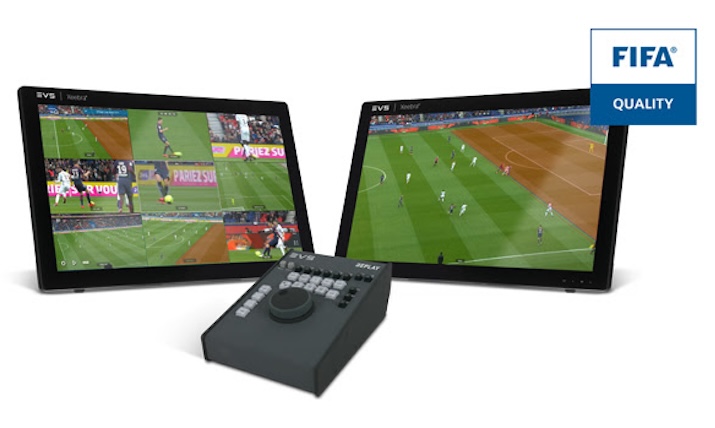MUMBAI: Storytelling needs to inform technology in sports broadcasting not the other way around. This was one of the points made during a panel discussion at the SVG India Summit 2025.
The session was called ‘Game Changers: Understanding the Top Five Global Tech Trends’
2025 will continue to see five key technology trends influence the way sports content is produced and delivered: IP; Generative AI; the Cloud; Extended Reality and AR; and Social Media. Leaders from the U.S. and India took to the stage to debate and discuss why they are important and what they mean to anr organisation.
The Moderator was:
Ken Kerschbaumer, SVG, Co-Executive Director, Editorial
The Panellists were:
Mike Davies, Fox Sports, EVP, Technical and Field Operations; SVG U.S. Chairman
Paul Devlin, Amazon Web Services, Global Strategy Leader, Betting, Gaming & Sports Technology
Rajat Nigam, Network18 Media, Group CTO
Alessandro Reitano, Sky Deutschland, SVP, Sports Production; SVG Europe, Chairman
Nigam noted that, sports production he sees as a high-intensity reality television wherein the storytelling has to be done in an unrestricted fashion and more so impactfully and instantaneously. And that brings in the challenges and the opportunities as well. “So, the five trends, what you mentioned, everything revolves around it’s insightful, it’s immersive, it’s impactful, it’s intelligence.
“And when we are talking of since I come from Indian industry, the fifth line would be Indian, Indian-ness. Because Indian consumer is highly emotional. we need to create content which connects with the consumers.
“And that makes the softer part of the creativity comes and takes over the technology. So, that’s an important ask. And everything we do has to be multi-fold. So, pluralism is the principle. The multitude of events, the tiering, the multitude fragments of consumers, the multiple platforms.” He gave the example of needing to enhance and make the content available even in an MRI machine. While the patient is inside for 12 to 15 minutes, he should have some content to get them engaged. Similarly, FM radio, the DRM, the company uses the FM radio channel for putting in sports data while the other content continues.
“So, these are the opportunities wherein we need to look at. And with more and more data available, more and more efficient algorithms which are coming up in the name of AI, we need to apply that and convert it into content which engages.”
The moderator agreed about the soft side of production. “He’s right. Because this is the mark of a really just an intelligent way to approach it is that storytelling needs to inform technology, not the other way around. And that too often an AI is a huge problem and a solution.”
A Flexible Ecosystem: Reitano was asked about trends that make the technology better, the trends in budgets, which obviously is a constant battle of getting enough budget in order to do things the way you want to do them. And third is the consumer trends that are shaping, driving operations at Sky Deutschland. Reitano noted that it’s different from a European perspective, it’s a different landscape. “This is a very saturated market. Obviously, we have to work in a different way.
“For us, it means tech trends is how we become super-efficient. So that means at the end of the day, our key principle, if you can automate things, you have to automate. We have our key events. But after that, we have a really, really close look at what can we automate in the content processing to cater every, let’s say, audience group we have to cater. And there’s a ton of platforms. There’s not only one linear channel.
“There’s OTT, there’s TikTok, there’s Facebook, there’s everything. And I think to get the thing done, you have to build an ecosystem which is possible to, let’s say, start from your localisation on site and get multiple outputs at the same time. So – and I see this as the most trending part. Whatever sits in the ecosystem will give us the ability to produce more content to the same amount of people. I’m not talking about less, the same amount of people. But we have to increase, let’s say, the content volume. It’s very simple. We run consultation. We run a 24-news channel on sports. And we have all the outputs, let’s say, which we have to deliver. And that’s why you have a very flexible ecosystem in place. And I think this is a trend.” For him its is important to be both flexible and scalable and adaptable what’s coming up next.
The Sky Advantage: He was asked that given the other entities within Sky across Europe if that gives him more buying power to get scalability more cost-effective? His reply was absolutely. “At the end of the day, what we share, is all worth it in the entire industry.” In terms of what is next he noted that if it comes to live operation, scalability, his company is working with Sky as a Sky on a Sky group platform. “I mean, we’re producing 25,000, 30,000 hours on linear channels, but the same amount of hours on our so-called bonus streams.
“And this sits entirely in the cloud. And this is based and leveraged by, let’s say, us, Sky Italia, Sky Austria, all the group affiliates at Sky. And it’s driven by Sky UK. So, we leverage the entire platform, which helps us to produce more content, everything cloud-based, data-driven. It is, for us, really important because we’re bypassing, let’s say, our production center and deliver, let’s say, more content for our customers. And this is, at the end of the day, this is everything what counts.
Learning From The US: He admitted that he admires US broadcasting because it always starts with entertainment and then comes to sports. It’s not the other way around. “Sometimes in Europe, we’re discussing too much, very serious about sports, and forget about the entertainment sector. And if you look into the demographics, what you see in front of you, they love entertainment, by the way. And sports is not only life.
“You have to wake up with sports. You go to bed with sports. In between, there’s tons of stories to tell. And this is, I think, one of those challenges for us as storytellers and production companies and services, how to cater everything. And this is all about the scalability. Yes, whenever you can leverage as a group, you have to leverage.”
Player Tracking’s Role In Storytelling: Devlin noted that his background pre-AWS was in high-performance sport. And so a lot of that involved player track. “Definitely a trend I’ve seen over the last probably ten years in high-performance, the last five years, all over the world, is that of player tracking. Trust me, from a performance side, it’s really important athletes perform, or you get fired, or that they don’t get injured.
“But we try our best to mitigate them getting injured. So there’s an awful lot of detail that goes into the analysis of that player tracking data and its impact on performance. A sub-segment of that is incredibly, incredibly valuable for storytelling.”
He shed light on how Bundesliga match facts are created. There are three million data points per game, and that is between 16 and 22 cameras in the stadium tracking the athletes ten times per second. That tracks them physically and tells you what they did, but it doesn’t tell you why they did it.
“It doesn’t tell you why a player sprinted up the sideline. What we then do is take the match event data, passes, shots, headers, free kicks, fouls, and we sync those two data sets together. And then quite simply use machine learning to ask questions that fans want answers to.
“So if you think about that particular match insight passing profile, before machine learning and player tracking and syncing of the two data sets, a good passer of the ball was a player who completed the most passes. That might be short passes, of two, three meters, continually over the game.That doesn’t help a fan understand the game at a deeper level.
“A good insight into the objective outcomes here was that the Bundesliga did a fan survey to check are these insights landing? Because at the end of the day, they’re an experiment, they’re what we call arms on a two-way door decision. And they found that 97% of their fans found it insightful and added value to them, which is a nice number.
“But for me, a really important number was that 90% of the fans surveyed said it helped them to better understand the game. What we’re doing and what we’re putting on screen helps fans to understand. The job of a striker is to put the ball in the goal. It’s very hard to do that. You would think you’re back to goal.
“Yet the striker is most effective there. A third of the time, 34% of his passes are actually back towards his own goal, which allows the shot to go and go. Previously, that depth of analysis and therefore storytelling in the broadcast just wasn’t possible.”
He said the same holds true for tennis, the NFL, cricket. “Tracking data, contextualised to enhance the storytelling for fan engagement.”
Working Backwards From Fans: He noted that a sports organisation must focus on working backwards from fans. That doesn’t always mean you get it right. And the spirit of experimentation is critical to that.
He gave the example of the F1 app. “What questions could we answer for fans? I think Formula 1, in particular, do an incredible job of this. When you look at the Formula 1 and the amount of insights that they generate.” He said that his oldest daughter is 18 now. She watched ‘Try To Survive’ and then downloaded the F1 app and enableed notifications.
She doesn’t watch F1 but knew that due to notifications that Lando Norris was not doing well. “And she was telling me about how Lando was struggling in comparison to Kimi Antonelli. And told me all about what was going on in Formula 1. Now, she’s never actually watched the full Formula 1 race. But she’s also not in that category where everyone says, oh, they only watch highlights. She doesn’t watch highlights either. She’s just reading the notifications and she watches the documentary. So, we think about the engagement for her as a fan.
“What she wants to know is a bit of the entertainment, a bit of the gossip, a bit of what’s going on. But she’s a fan at 18 years of age. Again, there’s different ways to engage. But you have to work backwards from the fact that they do use Amazon Personalise. Which is a machine learning tool that learns what the fan wants from the notification and pushes them the content that they want. Clearly, in that case, it’s working pretty well.”
Real-time Data Analysation And Visualisation Is The Future: Reitano was asked how the technology, the speed of the ability to use these systems, impacting, just making it better storytelling? He noted that
in his case it is offering xustomers a so-called technical feed. “It’s a dedicated feed next to our primary broadcast. You can watch really from a tactical perspective. So for all the tactical freaks, you have all the data coming in. And let’s say two years ago, it took us, let’s say, a minute for the turnaround to get the data visualized.
“Now we are, let’s say, up to 20 seconds. At the end of the day, you want to have real-time data analyzation and visualisation. Then you can predict things in your own language, what you want to predict. And I think this is, at the end of the day, this is from our perspective than the future. Not only by saying, okay, fans, you have a really tactical feed, but you can predict things by your own if you play around with data. So always what if, what if the striker would, let’s say, run 10K faster? I don’t know.
“Or he would left foot instead of a right foot. Then you would have all the prediction data coming in. But you want to predict it. But therefore, you need live-life visualization. That’s the really key. And that’s the thing what we’re working on.” The key is to make sure there is live data visualised instantly. “And then you call it up from your preference what you want to tell your customers. And that is your own dedicated story because it’s more than a simple storytelling, which position should be the striker in, in the box, out of the box, left foot, right foot.
“Then you can predict things. And I think this is where we want to head in the next couple of, the next season on because we have all the live-life data. And you told us there’s 3 million data points. it’s a lot of things coming into something. And then you have to visualize it. And you have to tell a story.
“And that’s why AI comes into to help us to make it better also for the storytellers.”
Devlin noted that this is a really good point. “All of these sports have been collecting data for such a long period now. It’s creating historical archives. So, as you mentioned, stats have been collecting data for a long time now.
All of the major football codes, same in cricket. There’s a ton of data there. And therefore, we’re seeing a trend of creating graphics out of that that help engage fans like we talked about.
“I think there is an exciting opportunity in the present but also the near future to enable fans to be able to do that should they wish. So, yeah, it might not be for everybody. It might not be in a major broadcast. But the ability for fans through second screen or even post-match to be able to dive into that data and then visualise it with natural language query, I think that’s an exciting development.”
AI Can Be An Issue: Davies noted that now you’re getting a lot of solutions looking for a problem, with AI crap. But just because you can use AI doesn’t mean you should. “So, my trend is it’s the tale of two worlds. It’s the tale of the flagship at the summit, the flagship shows, your cricket, your Bundesliga, my NFL.
“And those are the ones that we’re throwing money at. We’re throwing money at because we’re trying to increase the spectacle. The spectacle, these resource hunger shows and we’re putting more and more money in it. We’re not so much on the efficiency side on that. But in the mid-tier events, that’s where you’re really going to see where can we get a similar product or very much the same product using some very, you know, innovative ways.
“Now maybe you’re talking about automation, maybe you’re talking about remote technology, maybe you’re talking about all of the things that make production more efficient. And in some ways, the mid-tier productions, if you squint, is subsidising the top tiers. So you’re following the eyes.”
Nigam agreed saying that there is a need to create different levels of production.
“So the high or for the premium events, we deploy different sort of production techniques, which would entail more number of resources, more number of expenses as well. There would be certain events, or even the lower tiering of the same event, wherein we could use technology to optimise, to bring in automation, wherein the cost of production becomes low, as well as the number of resources and the dependency goes low. So the fragmentation is the key, wherein lot and lot of opportunities are there.
“How do you stitch that together? The pie remains constant. We have to allocate that pie to bring the value very quickly.”
Lower-end technology has become very capable: One trend pointed out in terms of technology is the lower-end technology is so capable now. Viacom 18 used iPhones at the Olympics last year. There are also automated camera systems. One can do very cost-effective shows with almost little compromise in terms of the overall production value. Davies noted that sometimes today’s efficiency technology becomes tomorrow’s enhancement technology and sometimes vice versa.
“So I think that we’re not necessarily interested in putting too much remotely or putting too much on automation on the flagship shows. But what you find is that sometimes that technology can have other uses. You think about, well, can this type of technology do auto-framing on a pylon camera? Now that might be a very small thing.
“I told you a hundred cameras. Maybe it doesn’t make air. It’s just what your risk tolerance is on that particular thing. And can you actually ascribe some improvement by using those things?”
Reitano noted that the good thing is on technology, and this is very helpful because it feeds also, let’s say, the customer you can produce more content on the lower end. “And you have to consider that there are tons of content out there. They were invisible the last couple of years because it was too expensive to produce them. And now you are capable, let’s say, halving with, let’s say, one camera, automating stitching, whatsoever. And you’re producing tons of more content and feeding, let’s say, the customer’s needs. So it gives us, if you accept the compromises, I think this is sometimes very, let’s say, hard to understandable for sea level.
“Because they are measuring whatever comes on Sky platform needs to be top-notch. And now you’re starting to compromise and producing more lower tiers.” He gave an example of in Mumbai an under-17 match-up taking place. And there were a problem with encoding and decoding. nd this is how you want to educate. How you educate your customer on different platforms. Because there is and must be a compromise.
“You can’t have resiliency and reliability on 100% if you’re having a fully automated camera system, which is cloud and IP only. So you have to find a compromise. But this is an education curve.
“You’re offering more content for your customers. On the same side, you’re lowering your production cost, which is part of your ecosystem. And then you have to find, let’s say, a good conversation with your customer base because they’re not paying more for that.
“This is absolutely a deal. We’re offering incremental services free of charge. But this is happening because customers are reacting. (24:12) They don’t care what they see. At the moment, if the Sky-corner bug is up, they’re expecting premium quality.”
Nigam was asked about 9×16 productions where one is actually using automated camera. Noigam said that those are the opportunities. “Yes, we do that. And I would pick the line that you mentioned earlier. You used an adjective along with artificial intelligence. So somehow that remains an elephant and somehow all of us tend to get obsessed by that.
“Fortunately or unfortunately, this has been there. AI is nothing but automation. And this has been there or various levels of automation has been there for many, many years. And all of us deploy those automations with respect to the live productions that we do.
“What the consumer requires is a plain, simple, good storytelling about that particular event. Like for cricket, the live event happens with seven cameras. The story gets completed in seven cameras wherein we tend to use more than 30 cameras. Now, how well the additional 25 or 30 cameras have to be used, that’s an option.
“The story gets completed in those seven cameras. And again, at the end of the day, the consumer is not bothered what is that being used at the back end. What it means is, for example, I would pick in this IPL, we have been doing a lot of different things. Each IPL match is getting produced in 25 different streams, getting distributed in more than 70 different ways, etc., etc. (26:08) But what it has caught the eye of the consumer is one physical feature which we call it as Champak. So, Champak, which is not an artificial intelligence thing.
“It’s a physical, physical technology product which has caught the eye of the consumer. So, that’s something innovation we need to bring in.
Just because we want to deploy artificial intelligence, that does not mean everything will get enhanced. We need to capture the spirit of the consumer, certainly keep them excited, keep them engaged. But then, there are ways to do it.”






































































